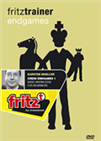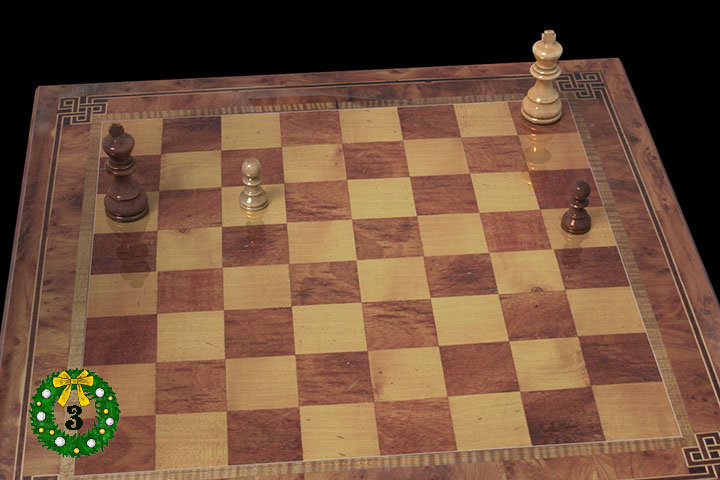Puzzled on the train
 Recently I was on a train trip — a four-hour journey here in Germany. Our trains have nice tables with four seats around them, and mine was shared with two young boys, one around twelve and the other in his late teens. They had a nice little wooden chess set and were playing a game. I watched and saw that they were rank beginners. The younger boy, Andreas, won the game — by not overlooking the chance to mate in one. He wanted another game, but his brother balked and started to occupy himself with his mobile phone. The lads were bored. I thought maybe I should offer to play Andreas. But then I had a different idea.
Recently I was on a train trip — a four-hour journey here in Germany. Our trains have nice tables with four seats around them, and mine was shared with two young boys, one around twelve and the other in his late teens. They had a nice little wooden chess set and were playing a game. I watched and saw that they were rank beginners. The younger boy, Andreas, won the game — by not overlooking the chance to mate in one. He wanted another game, but his brother balked and started to occupy himself with his mobile phone. The lads were bored. I thought maybe I should offer to play Andreas. But then I had a different idea.
"Here, let me show you a little problem," I said to the younger boy. "Tell me if you know it."
 Endgame theory constitutes the foundation of chess. You realize this in striking clarity once you obtain a won endgame but in the end have to be content with a draw in the end because of a lack of necessary know-how. Such accidents can only be prevented by building up a solid endgame technique. This is Karsten Müller‘s fi rst DVD and the grandmaster from Hamburg and endgame expert, here lays the foundation for acquiring such a technique. The fi rst part of his training series can be started without any endgame knowledge, only a knowledge of the rules of chess is assumed.
Endgame theory constitutes the foundation of chess. You realize this in striking clarity once you obtain a won endgame but in the end have to be content with a draw in the end because of a lack of necessary know-how. Such accidents can only be prevented by building up a solid endgame technique. This is Karsten Müller‘s fi rst DVD and the grandmaster from Hamburg and endgame expert, here lays the foundation for acquiring such a technique. The fi rst part of his training series can be started without any endgame knowledge, only a knowledge of the rules of chess is assumed.
He did not. I told him it was a famous "study," composed by a very strong chess champion almost exactly one hundred years ago. The requirement was that White would start and must force a draw. After making sure he knew which way the pawns went, Andreas started to move pieces on the board, trying to find a way to save the game for White. After a couple of minutes he said, emphatically: "It is impossible, Black can always win."
Now — and if you want to try it — this is the way you can get the attention of novice young chess players: I did not tell Andreas the solution, or even offer any hints or help. I just sat back and complacently repeated: "White can draw!" Suddenly his brother, who didn't want any more chess, had joined in, and the two boys started working on the problem systematically. Which meant they tried, half a dozen times, to catch the black a-pawn with the king. Each time Kh7, h6, h5 failed to work — the pawn promoted to a queen. They also tried to find a way to promote the white pawn, but Black always prevented that. In the end they reached the conclusion that it was completely hopeless: Black can always win, you can see that at first glance! But I stuck with my demand. Finally, they gave up and asked me to tell them "the trick." The older boy even considered the possibility that the way to draw was to pull out a baseball bat and threaten the black player, forcing him to accept a draw.
"Okay," I said, "if Black can always win, try to do it against me." They started playing and of course were not able to win. They tried again and again, and each time I was able to hold the draw. Now I explained the "Réti manoeuvre" to them. I told them how moving a king to chase the pawn did not have to be straight down the file, but could go diagonally just as fast — and follow a dual purpose in the process: to approach and threaten to defend the white pawn. If after 1.♔g7 h4 2.♔f6 Black played ...h3 White could change course and head for his own pawn, 3.♔e6, and ensure its promotion. If Black tried 2...♚b6 to eliminate the pawn, White could simply continue: 3.♔e5!, and if the black pawn continued with 3...h3 White could change course here, playing 4.♔d6! ensuring the white promotion. Try as they might they could not prevent me from defending the c-pawn — unless they spent two king moves to capture it, in which case my white king would catch their pawn.

Richard Réti | Photo: Ernst & Cesanek, Public domain via Wikimedia Commons
The point of this rather lengthy and detailed narrative is that these boys, in less than half an hour, had learnt something important about chess: that the game is not just about "stealing" (they used the German word "klauen") the other player's pieces; you can in fact do very clever things to win. You should have seen the pure joy on their faces when they had understood the Réti position fully. They couldn't stop grinning, and they asked for more. I have the feeling that they will be regulars in the chess groups in their schools now, looking for clever things to do in their games.
As I said, these young boys on a train were basically bored out of their minds, but were suddenly animated by chess and begging for more problems. So I gave them another Réti to solve:
Try as they might they could not solve this one either — who would think that the white king must go after the g-pawn and allow the f- or h-pawn to proceed towards promotion. But after I showed them 1.♔g6 h5 2.♔xg7 h4 ("That's rubbish, the black pawn promotes") 3.♔xf6 the older boy let out a colossal shriek: "It's the same as the other problem!" And he showed me how White can support his pawn, or stop the black one. The look on both faces was even more full of pride and joy.
German Rail now thankfully has Internet, so I could use my mobile phone to find more positions, ones I did not have in my head. Here's one I gave to and discussed with them:
I told them who the players were and how Siegbert Tarrasch was convinced that he was winning against World Champion Emanuel Lasker. But the latter found a Réti-like manoeuvre to save (and almost win) the game. We worked it out together, and although it is not trivially easy, in the end the boys understood everything perfectly, even the unlikely second move (why doesn't the more likely one work?). They actually found everything by playing the position out against me. You, dear reader, can do the same, against an engine, by moving the pieces on the diagram board above. You can also do the same on the second Réti diagram above.
We went through a few other similar positions, one of which I remember:
We had a lot of fun with this study, working out all the lines. I urge our readers to do the same, by moving the white pieces on the diagram board above — and not by pressing Alt-F2 in ChessBase or Fritz and getting the solution in a few milliseconds.
And finally: I gave them a position from a study that has been my favourite for many years:
Here the problem was: White cannot simply promote, because of the bishop skewer: 1.c8=♕? ♝f5+ 2.♔d6 ♝xc8 3.♔c5 ♚e4 4.♔b6 ♚d5 and the pawn on b7 will not fall — Black will simply use his king to accompany it to promotion.
So my question was: in the diagram position, which is the most unlikely move that White must play? They thought about 1.♔e6 ♚e4 (now the skewer on f5 still works) 2.♔d6 ♝f5 3.♔c5 ♝c8 and we have the same situation. Once again the boys said there was no possible way to draw. "Think Réti," I said, and with a little prompting they found the solution. "That is sooo cool!" Andreas said, and both spent many minutes just raving over the problem.
All I can do is stress again: just try all this on children who are starting to play chess. You will delight them no end, and you can make sure they do not give up the game. I am convinced that it is what I did for Andreas and his brother. Two more dedicated chess players in the world.
Links


















 Recently I was on a train trip — a four-hour journey here in Germany. Our trains have nice tables with four seats around them, and mine was shared with two young boys, one around twelve and the other in his late teens. They had a nice little wooden chess set and were playing a game. I watched and saw that they were rank beginners. The younger boy, Andreas, won the game — by not overlooking the chance to mate in one. He wanted another game, but his brother balked and started to occupy himself with his mobile phone. The lads were bored. I thought maybe I should offer to play Andreas. But then I had a different idea.
Recently I was on a train trip — a four-hour journey here in Germany. Our trains have nice tables with four seats around them, and mine was shared with two young boys, one around twelve and the other in his late teens. They had a nice little wooden chess set and were playing a game. I watched and saw that they were rank beginners. The younger boy, Andreas, won the game — by not overlooking the chance to mate in one. He wanted another game, but his brother balked and started to occupy himself with his mobile phone. The lads were bored. I thought maybe I should offer to play Andreas. But then I had a different idea.





